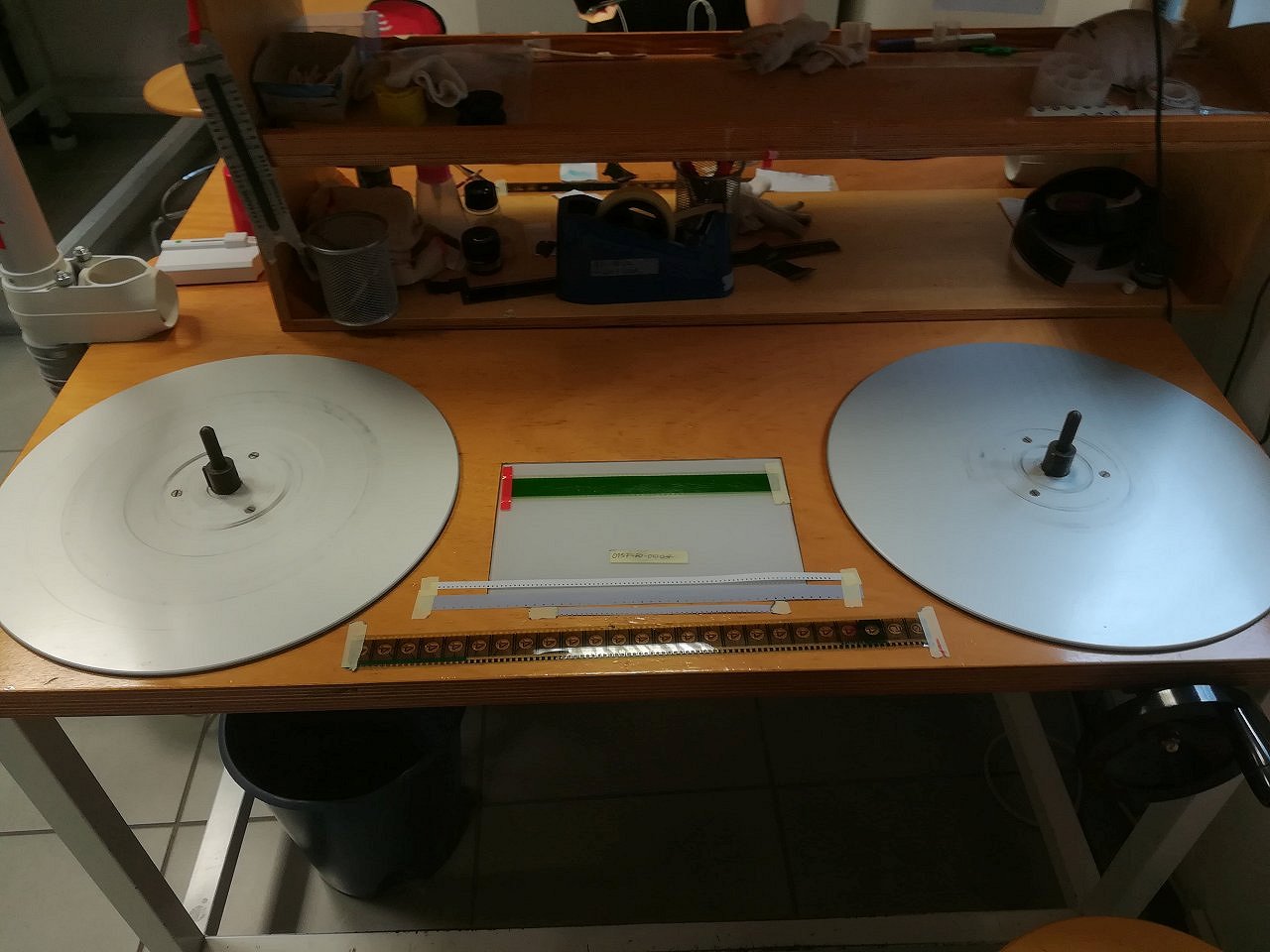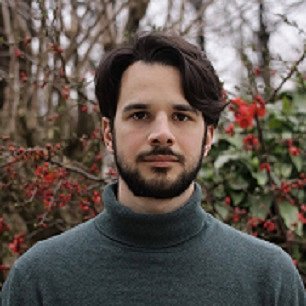Technical report on the digitalization of the Aljoša Žerjal fund "No to bilingualism"
11.4.2024

Introduction
The corpus digitized at this stage consists of thirty-four elements recorded on Super8 mm films produced by the Kodak company between 1988 and 1993. This data is evident from the presence of so-called edge codes, i.e. codes that the company prints on the edge of the film. If it is true that a filmmaker could shoot each individual reel after the date corresponding to the codes, then it is also true that he could not do so before they were produced. The laboratory phase therefore allows us to obtain the first important time indication, which may be more precisely defined during the analysis of the content of the films.
Even if the minimal difference in the actual dates does not surprise us, it is unlikely that the period of filming differed greatly from the dates deduced from the codes, since with such constant and abundant production it is difficult to assume that the filmmaker used the films more than a few years after the date he bought them. So here it is reasonable to assume that the recording almost coincided with the production date of film reels at the Kodak factories.
It is important that we can state without any major mistakes that this set was recorded during the breakup of the SFR Yugoslavia and the simultaneous birth of independent Slovenia. Below is a list of the number of recordings corresponding to each year, which can be understood from the edge codes:
1988 7 recordings
1989 9 recordings
1990 3 recordings
1991 3 recordings
1992 0 recordings
1993 12 recordings
Examination and archiving of materials
The first step in the processing according to the protocol used in the "La Camera Ottica" laboratory is the digital archiving in the laboratory database called Dagma, where the metadata of all the audiovisual documents processed in it are stored. Therefore, it was necessary to pre-label the elements with a new identification mark, consisting of the fund number (in this case 0330), the mark that they are original Super 8 mm (B) and duplicates (O) and a four-digit serial number for each element. Any Dagma code referring to elements of this fund will therefore be of the type 0330-BO-xxxx. The exceptions are elements 0330-BO-0015A and 0330-BO-0015B, which were marked like that because they were found in the same envelope, and this fact was already taken into account by the archive number assigned by Kinoatelje. In fact, the two elements were designated as "171" and "171 bis" respectively. An examination of the contents, as we shall see, will allow us to argue that such an arrangement is likely to be accidental, as there is no continuity in the recorded material, nor in the years indicated by the edge codes, with element A being 1988 and element B being 1989.
The archiving phase is completed with photographic documentation of the items and their boxes, at the time they entered the laboratory and were assigned the appropriate code.
The next stage is a physical inspection, during which we check the condition of the film and repair any perforations or broken links. The only problem here was the fact that individual rolls had a damaged tail at the end because the rear frames of all the elements were folded while being inserted into the reel slot. This final warping causes film instability and misalignment, so we shouldn't be surprised if the final seconds of each digital copy show blurring or unnatural image movement.
Since all elements have a very short duration, two sets were created for practicality, each containing about half of all elements. These were well separated by the use of an inert tail on which the Dagma code was attributed. In this way, the scanner only had to be loaded and unloaded twice instead of thirty-four times.
Digital capturing and completion of the laboratory phase
The material was scanned using the 2.3K overscan technique. This means that the framing was done well beyond the border of the frame and thus also covered the perforations on the film strip. The resolution of 2336 x 1752 pixels allows us to create accessible copies in full high resolution, even if only the image area is enlarged.
A frame count of each element was also performed during the scanning phase, which is extremely useful information for determining their exact length. From the writings of theorist Alfonso Del Amo García, we learn that the pitch of Super 8 mm film is one seventy-second of a foot long, or 4.234 mm. The actual size of the photogram is 5.69 mm x 4.22 mm.
The digitized part of the fund covers a total of 98,484 frames, an average of 2897 for each element. The shortest element covers 726 frames and the longest 3650 frames. Physically, this means a total length of 416.98 m and an average of 12.26 m for each element. The shortest clip is 3.07m long and the longest 15.45m.
After the acquisition of the image material, the films were disassembled and re-stored in their original form in their original boxes. The tail, which served to separate the individual elements, was cut in two, leaving the Dagma code visible at the beginning and end of each. In this way, in the future we can avoid twisting the part of the film that carries the photograms when re-inserting it into the reel slot.
Corpus content
When watching the videos and by noting the content of individual elements in real time, it became clear that the same themes can be found in different reels and the same events can be recognized. In the first year among those available relating to edge codes, i.e. 1988, we discover that four out of seven images represent houses and rural landscapes. In one case, we have footage of a seaside holiday in Apulia, and the last two elements from 1988 contain what the entire corpus takes its name from, namely footage of demonstrations by the Young Front and other Italian right-wing groups against the recognition of Italian-Slovenian bilingualism in the city of Trieste.
Moving on to the next year, we find ourselves in a more heterogeneous situation, as we never find more than two reels containing the same theme. In more detail, we have two clips of traffic signs - signposts, the Slovenian inscription of which was destroyed by "Vandals" (with a capital letter), two clips in which the author creates a visual metaphor between barbed wire and roses, and two clips of the seventieth anniversary of the burning of the National House in Trieste by the already mentioned "Vandals" with a capital letter. Of the three remaining reels (there are nine in total), one is dedicated to testing the zoom in Trieste's Piazza Unità, the other to shots of a country house and the last to the same event that already appeared in the 1988 films.
I will focus on the last one in particular: from an in-depth analysis of three videos of the demonstrations (two edge-coded from 1988 and one marked 1989), it is obvious that it is the same demonstration. In particular, it is possible to identify the same banners at the rally, which are in the same order and at the same distance from each other. This allows us to also place the other two items in 1989. If the event had actually occurred in 1988, the third recording from that day in 1989 would not have been found. But it is possible that the opposite happened, i.e. that of the three reels that Žerjal recorded that day, one was recorded recently, and the other two in the previous year. Something similar is also happening with the two recordings on the seventieth anniversary of the fire in the National House, because we know that the fire occurred in 1920 and therefore the commemoration could only take place in 1990, regardless of the edge codes. Special attention should be paid to this fact, since these recordings are the only ones for which a more precise dating is possible than that offered by the film strip on which they were recorded. Precisely because of the important information provided by the dated event, we can emphasize again that the dates indicated by the codes printed on the film cannot be considered too reliable, although their presence is still very important.
If we continue with the analysis, we have three shots that are marked with the year 1990 and were most likely taken on the same occasion (two of the three certainly were), as they show a car driving on the Trieste highway, with a particularly exposed view of the harbor and some folk suburbs like Valmaura.
There are three recordings from 1991 in the collection. In this case, it is impossible to determine whether they were recorded together, but they certainly all deal with the same subject. Namely, they show gravestones with inscriptions in Slovenian dedicated to partisans and partisan commemorations.
Let's move to 1993, in which we find twelve recordings. Given the amount of material and the already known problems with dating, it is possible that some of them were recorded in the following year or even later. The most recurring theme is Rižarna pri Sveti Soboti, which can be found on the four reels showing the commemorations there (it's a good place to check here if the commemoration in 1991 was also filmed at the same location). Another important part from 1993 is the commemoration that took place at the Austro-Hungarian War Cemetery. Two clips also show monuments to Slovenian partisans smeared with red paint and the moment when a banner reading "No to bilingualism" appears on the windows of the headquarters of the Lega Nazionale. Furthermore, we have a film showing some Venetian villages, especially the hamlets of the municipality of Podbonesec (Pulfero), and one reel with variations of the opening credits. The last in the series of images from this year shows black and white photographs with an industrial theme from around the beginning of the twentieth century. Here it is hard to tell whether it is a shipyard, a mine or a factory.
A final note worth making regarding the content is that elements 171 and 171bis have nothing in common, as the former depicts a country house, while the latter commemorates the seventieth anniversary of the burning of the National House. The videos also have different edge codes.
In summary, we can therefore divide these topics into:
- hostility towards minorities by fascists, both then and now (demonstrations, painted signs, vandalized monuments)
- memory of innocent victims (commemorations in Rižarna, Austro-Hungarian cemetery, partisans)
- rural context
- port and industrial machinery
Conclusion
The corpus contained in the famous box "No to bilingualism" is placed in the wider context of the rich amateur cinematographic production of Aljoša Žerjal. The range of the entire scope of the fund is evident from, among other things, the already existing archival serial numbers of the individual elements that make up this corpus, which range from 157 to 189. Digitization of the remaining elements in the future would be extremely useful for additional understanding of the elements that were processed in this phase. In fact, much remains to be discovered in order to answer all the questions that arise with this corpus and to be able to understand for what purpose was this material actually recorded. As Paolo Caneppele says: "materials are really like little children: firstly, they don't talk to strangers, and secondly, only if we know the exact questions to ask them will we find the answers we're looking for."
Dario Rizzo (1993) is employed at the Institute for Slovenian Culture in Špeter Slovenov. At the same time, he leads the cultural projects of the Center for Cultural Research Lusevera (Bardo), which are primarily aimed at protecting the cultural heritage of the Torre valleys.





